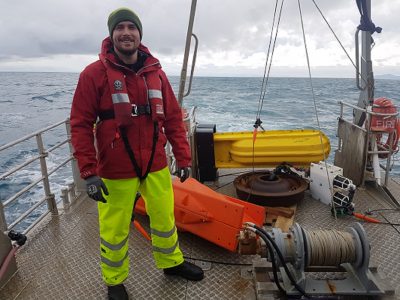Burnside High School – Carl Johnston

2016 | Applications of physics within oceanography, fisheries and seismology
School: Burnside High School
Host: NIWA, Wellington
Region: Canterbury
Carl has worked in the field of education for five years, teaching junior science and senior physics at Burnside High School in Christchurch. He is passionate about stimulating student’s curiosity to learn about the physical and natural world around them through the use of relevant and purposeful science experiences.
Over the last six months, Carl has worked alongside scientists in the marine physics group at the National Institute of Water and Atmospheric Research (NIWA) in Wellington. Through first-hand science experiences, he has been able to articulate his understanding for the Nature of Science and feels better equipped for educating students with key scientific skills like the ability to gather and use scientific evidence, to interpret and critique data and question the biological or physical significance of scientific results. Carl’s most memorable experience at NIWA was a three week voyage on New Zealand’s only deep-water research vessel, the RV Tangaroa (70m). During this multidisciplinary voyage he worked 12 hour shifts with NIWA biogeochemists and physical oceanographers in a bid to understand the connection between physics and biology around the continental shelf east of Auckland, New Zealand. During a typical day at sea, Carl could be found filtering zooplankton in preparation for gut fluoresce and biomass analysis, extracting Thorium from seawater using a chemical extraction process, setting up pumps to filter sediment from deep seawater samples, processing sediment core samples from the sea floor or downloading environmental variables from a CTD instrument (used to determine the conductivity, temperature, and depth of the ocean). In addition to his voyage, Carl assisted with a 21 day outdoor experiment as part of a project investigating the impacts of ocean acidification on New Zealand’s marine environment. The experiment took place in nine 4000-litre tubes, known as mesocosms, filled with seawater at NIWA’s Greta Point facility. The objective was to determine how phytoplankton and zooplankton communities respond to changes in temperature and pH projected for this region as a result of climate change. Carl was also able to visit other NIWA branches around New Zealand, enabling him to build a broader picture for the diversity of science at NIWA while developing a network of reliable contacts and future teaching resources.
From the school’s perspective, having Carl participate in the Science Teaching Leadership Programme allows him to experience scientific research first-hand and bring real scientific experiences back to students and staff that can be incorporated into the schools science education. Burnside High School also hopes to develop and maintain educational links with NIWA so students can learn from and collaborate with current scientists and their research.
When Carl returns to school, he will be able to use the leadership skills and curriculum knowledge gained from the programme to enrich science teaching units by incorporating relevant, engaging science experiences with a focus on the five science capabilities: gathering and interpreting data, using and critiquing evidence, interpreting representations and engaging with science.
“We are not talking about what to teach; we are talking about what science is. It is not science to know how to change Centigrade to Fahrenheit. It’s necessary, but it is not exactly science.”
— Richard P. Feynman
